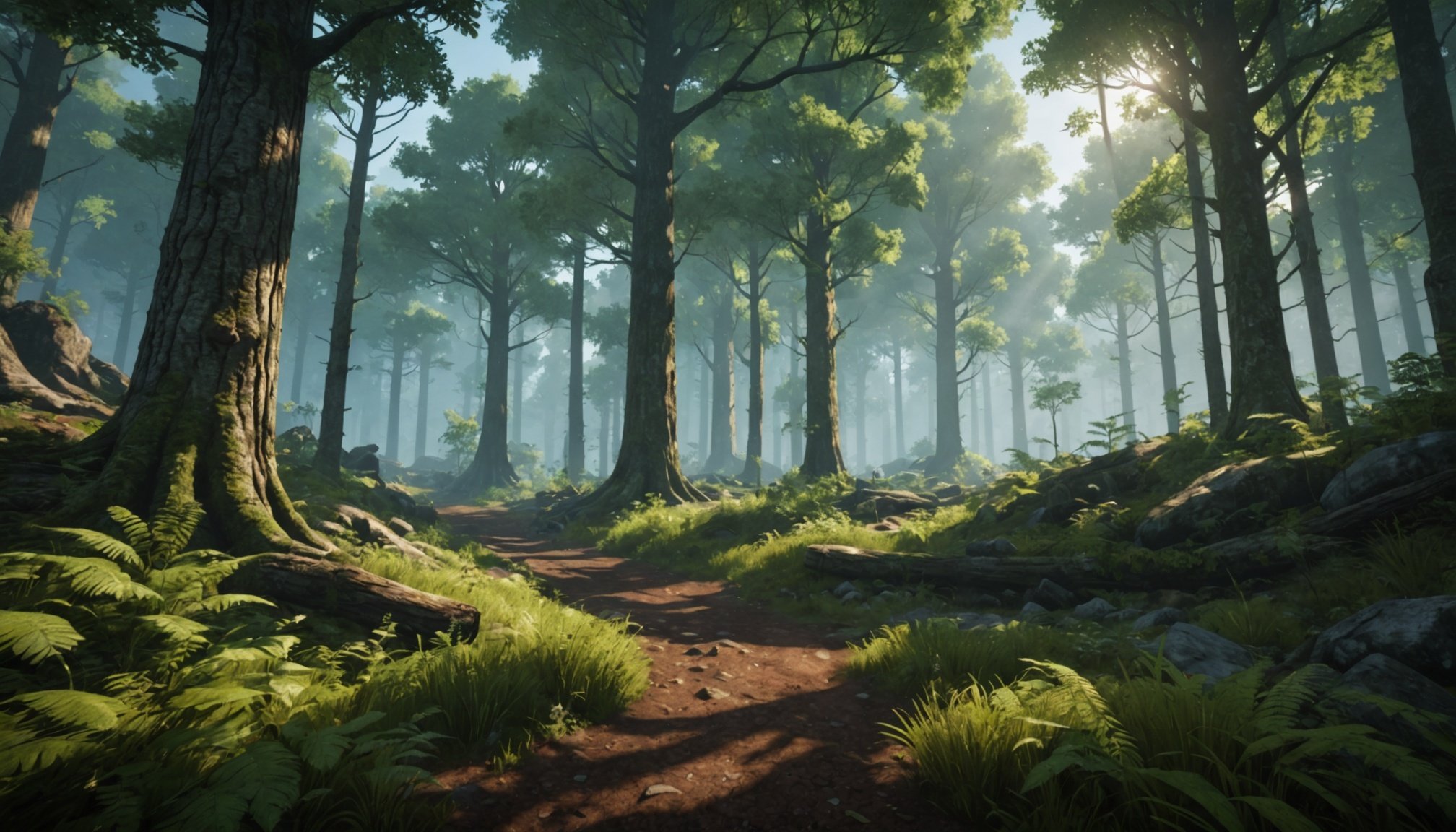Importance of Lifelike Foliage in Exploration Games
The realism in game design is fundamental to creating captivating and immersive environments that pull players into their virtual worlds. Central to this experience is the use of lifelike foliage, which can significantly enhance a player’s visual experience. Realistic foliage not only adds beauty but also deepens the gameplay dynamics by making exploration feel more genuine and engrossing.
In the context of these games, foliage serves as more than just a background element; it’s crucial for creating an environment that feels alive. It adds layers of depth to landscapes, making them seem more authentic and inviting for players to explore. This level of realism can influence how a player navigates through the game world, offering both challenges and opportunities for discovery.
In the same genre : Overcoming obstacles: essential challenges in developing games for hybrid vr and ar platforms
Several popular games have mastered the art of utilizing lifelike foliage to its fullest. Titles like The Witcher 3: Wild Hunt and Red Dead Redemption 2 are celebrated for their lush, dynamic environments that react to player actions, enhancing the overall immersive environments. These games demonstrate how vital realistic foliage is in crafting a compelling and explorative gaming experience.
Techniques for Creating Realistic Foliage
Developing realistic foliage in 3D environments requires a nuanced understanding of foliage creation techniques. These incorporate a range of 3D modeling tips to enhance visual rendering. Achieving this involves a blend of skillful modeling, texturing, and animating. Below, we’ll delve into these facets.
Also to read : Overcoming challenges: integrating authentic physics in space simulation games
3D Modeling Best Practices
When embarking on foliage design, selecting effective 3D modeling software is crucial. Tools such as Blender and Autodesk Maya provide robust platforms for creating intricate leaf structures. One critical tip is optimizing polygon count. By maintaining a balance between detail and performance, designers ensure smooth rendering without compromising on aesthetics.
Crafting natural shapes and sizes in foliage is an essential aspect of realistic design. Implementing real-world references gives a foundation for scaling leaves appropriately. Combining these references with adjustable sprout functions leads to authentic appearances.
Texturing Approaches
High-quality textures directly impact the realism of digital foliage. Seamless texture maps are fundamental. Techniques such as blending textures or utilizing procedural generation can enhance the surface depth, offering a more immersive experience. Recommended resources like Substance Source provide a plethora of options for designers seeking realistic foliage textures.
Implementing these 3D modeling tips and foliage rendering techniques ensures that the foliage feels authentic and vibrant in any digital landscape.
Lighting Effects for Enhanced Realism
The impact of lighting techniques in revealing foliage details cannot be overstated. By highlighting textures and depth, lighting adds life to digital landscapes, creating an immersive experience. Particularly, when light passes through leaves, the resulting play of shadows and reflections enhances the realism, making the environmental ambiance more convincing.
One exciting approach in digital environments is simulating natural light dynamics, such as sun cycles. By manipulating the position, intensity, and colour of light sources, creators can mimic how sunlight changes throughout the day. This adds variation and richness, offering players a more engaging experience. Daytime transitions can impact shadow length and direction, adding realism. As the sun rises or sets, the warm hues and long shadows transform virtual worlds into masterpieces of art.
Some notable exploration games exemplify dynamic lighting strategies superbly. For instance, in games like “The Legend of Zelda: Breath of the Wild,” developers have used dynamic lighting to create picturesque landscapes. The shadows cast by trees or the soft light filtering through branches bring a level of detail that feels authentic. By employing these strategies, developers craft worlds that not only amaze visually but also draw players deeper into their virtual realms.
Environmental Storytelling through Foliage
In the realm of narrative design, foliage plays a subtle yet powerful role. It serves as a tool for delivering environmental cues that can transform any game setting into an immersive storytelling experience.
Using Foliage to Convey Atmosphere
Choosing the right foliage is crucial for setting the tone of a game environment. Game designers should strategically select foliage types that match and enhance the atmosphere of their settings. For example, lush, vibrant foliage can indicate life and prosperity, while decaying or sparse vegetation might suggest desolation or danger.
Color palettes are another important consideration. By tweaking colors, developers can enhance the emotional impact of their landscapes. Warm hues may create an inviting ambiance, while cooler tones can evoke a sense of mystery or unease.
Some standout games employ foliage brilliantly to serve their narratives. In “The Last of Us,” overgrown post-apocalyptic landscapes communicate themes of both ruin and resilience. “Firewatch” uses the red and orange hues of its forest setting to evoke the raw emotion of its narrative.
This careful use of foliage can cement the player’s emotional connection to the environment, reinforcing the storyline through a natural and intuitive medium.
Resources and Tutorials for Foliage Creation
Creating realistic foliage in games requires a thoughtful selection of tools for game development. These tools are integral for artists aiming to simulate lifelike environments. One essential tool is SpeedTree, renowned for its robust features that accommodate detailed foliage modelling. Another valuable software is Blender, which offers versatile options with its varied plugins for perfecting foliage design.
Finding quality foliage design resources can significantly enhance the learning curve. Online tutorials, such as those available on platforms like Gumroad and Udemy, provide step-by-step guidance. These tutorials often cover intricate aspects of foliage creation, from texturing to shading, making them a top choice for beginners and seasoned developers alike.
Participating in active communities and forums can further enrich your skills. Engaging with platforms like Polycount can offer insights and shared techniques that are invaluable for personal growth and project success. Forums are great for seeking recommendations and understanding evolving trends in game development tools and methods. Exploring these resources enables creators to refine their craftsmanship and contribute to extended conversations around foliage creation in gaming environments.






